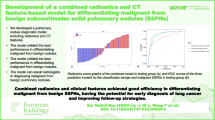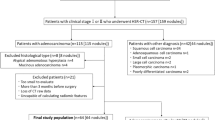Abstract
Lung cancer is the most lethal malignant neoplasm worldwide, with an annual estimated rate of 1.8 million deaths. Computed tomography has been widely used to diagnose and detect lung cancer, but its diagnosis remains an intricate and challenging work, even for experienced radiologists. Computer-aided diagnosis tools and radiomics tools have provided support to the radiologist’s decision, acting as a second opinion. The main focus of these tools has been to analyze the intranodular zone; nevertheless, recent works indicate that the interaction between the nodule and its surroundings (perinodular zone) could be relevant to the diagnosis process. However, only a few works have investigated the importance of specific attributes of the perinodular zone and have shown how important they are in the classification of lung nodules. In this context, the purpose of this work is to evaluate the impact of using the perinodular zone on the characterization of lung lesions. Motivated by reproducible research, we used a large public dataset of solid lung nodule images and extracted fine-tuned radiomic attributes from the perinodular and intranodular zones. Our best-evaluated model obtained an average AUC of 0.916, an accuracy of 84.26%, a sensitivity of 84.45%, and specificity of 83.84%. The combination of attributes from the perinodular and intranodular zones in the image characterization resulted in an improvement in all the metrics analyzed when compared to intranodular-only characterization. Therefore, our results highlighted the importance of using the perinodular zone in the solid pulmonary nodules classification process.






Similar content being viewed by others
References
Siegel RL, Miller KD, Jemal A: Cancer statistics, 2020. CA: A Cancer Journal for Clinicians 70(1), 7–30 (2020). https://acsjournals.onlinelibrary.wiley.com/doi/abs/10.3322/caac.21590
Bray F, Ferlay J, Soerjomataram I, Siegel RL, Torre LA, Jemal A: Global cancer statistics 2018: Globocan estimates of incidence and mortality worldwide for 36 cancers in 185 countries. CA: A Cancer Journal for Clinicians 68(6), 394–424 (2018). https://acsjournals.onlinelibrary.wiley.com/doi/abs/10.3322/caac.21492
Huang P, Park S, Yan R, Lee J, Chu LC, Lin CT, Hussien A, Rathmell J, Thomas B, Chen C, HalS R, Ettinger DS, Brock M, Hu P, Fishman EK, Gabrielson E, Lam S: Added value of computer-aided CT image features for early lung cancer diagnosis with small pulmonary nodules: A matched case-control study. Radiology 286(1), 286–295 (2018). https://doi.org/10.1148/radiol.2017162725
Nishi SP, Zhou J, Okereke I, Kuo YF, Goodwin J: Use of imaging and diagnostic procedures after low-dose ct screening for lung cancer. Chest 157(2), 427 – 434 (2020)
Schreuder A, van Ginneken B, Scholten ET, Jacobs C, Prokop M, Sverzellati N, Desai SR, Devaraj A, Schaefer-Prokop CM: Classification of ct pulmonary opacities as perifissural nodules: Reader variability. Radiology 288(3), 867–875 (2018)
Aerts H, et al: Decoding tumour phenotype by noninvasive imaging using a quantitative radiomics approach. Nat Commun 5, 4006 (2014). https://doi.org/10.1038/ncomms5006
Armato SG, et al: The lung image database consortium (LIDC) and image database resource initiative (IDRI): a completed reference database of lung nodules on CT scans. Med Phys 38(2), 915–931 (2011)
Bartholmai B, et al: Pulmonary Nodule Characterization, Including Computer Analysis and Quantitative Features. J Thorac Imaging 30(2), 139–156 (2015)
Bayanati H, Thornhill ER, Souza CA, Sethi-Virmani V, Gupta A, Maziak D, Amjadi K, Dennie C: Quantitative CT texture and shape analysis: Can it differentiate benign and malignant mediastinal lymph nodes in patients with primary lung cancer? European Radiology 25(2), 480–487 (2015). https://doi.org/10.1007/s00330-014-3420-6
Beig N, Khorrami M, Alilou M, Prasanna P, Braman N, Orooji M, Rakshit S, Bera K, Rajiah P, Ginsberg J, Donatelli C, Thawani R, Yang M, Jacono F, Tiwari P, Velcheti V, Gilkeson R, Linden P, Madabhushi A: Perinodular and intranodular radiomic features on lung ct images distinguish adenocarcinomas from granulomas. Radiology 290(3), 783–792 (2019). https://doi.org/10.1148/radiol.2018180910
Choy G, Khalilzadeh O, Michalski M, Do S, Samir AE, Pianykh OS, Geis JR, Pandharipande, PV, Brink JA, Dreyer KJ: Current applications and future impact of machine learning in radiology. Radiology 288(2), 318–328 (2018). https://doi.org/10.1148/radiol.2018171820. https://pubmed.ncbi.nlm.nih.gov/29944078
Davnall F, Yip CS, Ljungqvist G, Selmi M, Ng F, Sanghera B, Ganeshan B, Miles KA, Cook GJ, Goh V: Assessment of tumor heterogeneity: An emerging imaging tool for clinical practice? (2012). 10.1007/s13244-012-0196-6. https://insightsimaging.springeropen.com/articles/10.1007/s13244-012-0196-6
Degnan AJ, Ghobadi EH, Hardy P, Krupinski E, Scali EP, Stratchko L, Ulano A, Walker E, Wasnik AP, Auffermann WF: Perceptual and interpretive error in diagnostic radiology causes and potential solutions. Acad Radiol 26(6), 833–845 (2019)
Dhara AK, Mukhopadhyay S, Dutta A, Garg M, Khandelwal N: A Combination of Shape and Texture Features for Classification of Pulmonary Nodules in Lung CT Images. J Digit Imaging 29(4), 466–475 (2016). https://doi.org/10.1007/s10278-015-9857-6
Dilger SKN, Uthoff J, Judisch A, Hammond E, Mott SL, Smith BJ, Newell JDJ, Hoffman EA, Sieren JC: Improved pulmonary nodule classification utilizing quantitative lung parenchyma features. pp. 041,004–041,004. Society of Photo-Optical Instrumentation Engineers (2015). https://doi.org/10.1117/1.JMI.2.4.041004. https://pubmed.ncbi.nlm.nih.gov/26870744
Felix A, Oliveira M, Machado A, Raniery J: Using 3d texture and margin sharpness features on classification of small pulmonary nodules. In: 2016 29th SIBGRAPI Conference on Graphics, Patterns and Images (SIBGRAPI), pp. 394–400 (2016)
Ferreira JRJ, Oliveira MC, de Azevedo-Marques PM: Characterization of pulmonary nodules based on features of margin sharpness and texture. J Digit Imaging 31(4), 451–463 (2018). https://doi.org/10.1007/s10278-017-0029-8. https://pubmed.ncbi.nlm.nih.gov/29047033
Ferreira-Junior JR, Koenigkam-Santos M, Tenorio APM, Faleiros MC, Cipriano FEG, Fabro AT, Nappi J, Yoshida H, de Azevedo-Marques PM.: Ct-based radiomics for prediction of histologic subtype and metastatic disease in primary malignant lung neoplasms. Int J Comput Assist Radiol Surg 15(1), 163–172 (2020)
Firmino M, Angelo G, Morais H, Dantas MR, Valentim R: Computer-aided detection (cade) and diagnosis (cadx) system for lung cancer with likelihood of malignancy. BioMedical Engineering OnLine 15(1), 2–17 (2016). https://doi.org/10.1186/s12938-015-0120-7. https://doi.org/10.1186/s12938-015-0120-7
Ganeshan B, Panayiotou E, Burnand K, Dizdarevic S, Miles K: Tumour heterogeneity in non-small cell lung carcinoma assessed by CT texture analysis: A potential marker of survival. Eur Radiol 22(4), 796–802 (2012). https://doi.org/10.1007/s00330-011-2319-8
Haralick RM, Shanmugam K, Dinstein I: Textural features for image classification. IEEE Transactions on Systems, Man, and Cybernetics SMC-3(6), 610–621 (1973). https://doi.org/10.1109/TSMC.1973.4309314
Hsu JS, Han IT, Tsai TH, Lin SF, Jaw TS, Liu GC, Chou SH, Chong IW, Chen CY: Pleural tags on ct scans to predict visceral pleural invasion of non-small cell lung cancer that does not abut the pleura. Radiology 279(2), 590–596 (2016). PMID: 26653684 https://doi.org/10.1148/radiol.2015151120.
Kai Huang L, J Iun M, Wangt J: Image thresholding by minimizing the measure of fuzziness. In: Pattern Recognition, 1995,28(1):41-51. 113 International Archives of the Photogrammetry, Remote Sensing and Spatial Information Sciences. Vol. XXXVII. Part B2. Beijing 2008 (1995).
Il-Seok Oh, Jin-Seon Lee, Byung-Ro Moon: Hybrid genetic algorithms for feature selection. IEEE Transactions on Pattern Analysis and Machine Intelligence 26(11), 1424–1437 (2004). https://doi.org/10.1109/TPAMI.2004.105
Judisch, A., Hoffman, E.A., Newell, J.D., Sieren, J.C.: The Use Of Surrounding Lung Parenchyma For The Automated Classification Of Pulmonary Nodules, pp. A5457–A5457. https://www.atsjournals.org/doi/abs/10.1164/ajrccm-conference.2013.187.1_MeetingAbstracts.A5457
Junior JRF, Oliveira MC, de Azevedo-Marques PM: Cloud-based nosql open database of pulmonary nodules for computer-aided lung cancer diagnosis and reproducible research. J Digit Imaging 29(6), 716–729 (2016)
Kadir T, Gleeson F: Lung cancer prediction using machine learning and advanced imaging techniques. Translational lung cancer research 7(3), 304–312 (2018). https://pubmed.ncbi.nlm.nih.gov/30050768
Leardi R, Boggia R, Terrile M: Genetic algorithms as a strategy for feature selection. J Chemom 6(5), 267–281 (1992). https://onlinelibrary.wiley.com/doi/abs/10.1002/cem.1180060506
Lima LL, Ferreira Junior JR, Oliveira MC: Toward classifying small lung nodules with hyperparameter optimization of convolutional neural networks. Comput Intell 1–20 (2020). https://onlinelibrary.wiley.com/doi/abs/10.1111/coin.12350
Nembrini S, Knig IR, Wright MN: The revival of the Gini importance? Bioinformatics 34(21), 3711–3718 (2018). https://doi.org/10.1093/bioinformatics/bty373
Nettleton DF, Orriols-Puig A, Fornells A: A study of the effect of different types of noise on the precision of supervised learning techniques. Artif Intell Rev 33(4), 275–306 (2010). https://doi.org/10.1007/s10462-010-9156-z
Nishio M, Sugiyama O, Yakami M, Ueno S, Kubo T, Kuroda T, Togashi K: Computer-aided diagnosis of lung nodule classification between benign nodule, primary lung cancer, and metastatic lung cancer at different image size using deep convolutional neural network with transfer learning. PloS one 13(7), e0200,721–e0200,721 (2018). https://pubmed.ncbi.nlm.nih.gov/30052644
Pinsky PF, Gierada DS, Nath PH, Kazerooni E, Amorosa J: National lung screening trial: Variability in nodule detection rates in chest ct studies. Radiology 268(3), 865–873 (2013)
Shariaty F, Mousavi M: Application of cad systems for the automatic detection of lung nodules. Informatics in Medicine Unlocked 15, 100,173 (2019). http://www.sciencedirect.com/science/article/pii/S2352914818301382
Snoeckx A, Reyntiens P, Desbuquoit D, Spinhoven MJ, Van Schil PE, van Meerbeeck JP, Parizel PM: Evaluation of the solitary pulmonary nodule: size matters, but do not ignore the power of morphology (2018). https://doi.org/10.1007/s13244-017-0581-2
Uthoff J, Stephens MJ, Newell Jr JD, Hoffman EA, Larson J, Koehn N, De Stefano FA, Lusk CM, Wenzlaff AS, Watza D, Neslund-Dudas C, Carr LL, Lynch DA, Schwartz A.G, Sieren JC: Machine learning approach for distinguishing malignant and benign lung nodules utilizing standardized perinodular parenchymal features from ct. Med Phys 46(7), 3207–3216 (2019). https://aapm.onlinelibrary.wiley.com/doi/abs/10.1002/mp.13592
Van Riel, S., Jacobs, C., Scholten, E.: Observer variability for lung-rads categorisation of lung cancer screening cts: impact on patient management. Eur Radiol 29(1), 924–931 (2019)
Wang X, Leader JK, Wang R, Wilson D, Herman J, Yuan JM, Pu J: Vasculature surrounding a nodule: A novel lung cancer biomarker. Lung Cancer 114, 38–43 (2017). https://aapm.onlinelibrary.wiley.com/doi/abs/10.1002/mp.13592
Wei G, Cao H, Ma H, Qi S, Qian W, Ma Z: Content-based image retrieval for lung nodule classification using texture features and learned distance metric. J Med Sys 42(1), 13 (2017). https://doi.org/10.1007/s10916-017-0874-5
Wormanns D, Hamer O: Glossary of terms for thoracic imaging–german version of the fleischner society recommendations. RoFo: Fortschritte auf dem Gebiete der Rontgenstrahlen und der Nuklearmedizin 187(8), 638–61 (2015)
Xu J, et al: Quantifying the margin sharpness of lesions on radiological images for content-based image retrieval. Med Phys 39, 5405–18 (2012). https://doi.org/10.1118/1.4739507
Yang, J., Honavar, V.: Feature Subset Selection Using a Genetic Algorithm, pp. 117–136. Springer US, Boston, MA (1998). 10.1007/978-1-4615-5725-88. URL https://doi.org/10.1007/978-1-4615-5725-8_8
Author information
Authors and Affiliations
Corresponding author
Ethics declarations
Conflicts of interest
On behalf of all authors, the corresponding author states that there is no conflict of interest.
Additional information
Publisher’s Note
Springer Nature remains neutral with regard to jurisdictional claims in published maps and institutional affiliations.
Rights and permissions
About this article
Cite this article
Calheiros, J.L.L., de Amorim, L.B.V., de Lima, L.L. et al. The Effects of Perinodular Features on Solid Lung Nodule Classification. J Digit Imaging 34, 798–810 (2021). https://doi.org/10.1007/s10278-021-00453-2
Received:
Revised:
Accepted:
Published:
Issue Date:
DOI: https://doi.org/10.1007/s10278-021-00453-2




